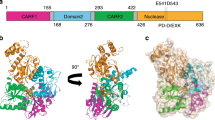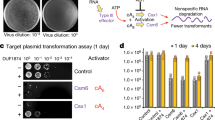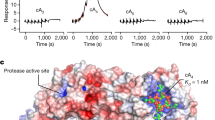Abstract
The CRISPR system provides adaptive immunity against mobile genetic elements in prokaryotes, using small CRISPR RNAs that direct effector complexes to degrade invading nucleic acids1,2,3. Type III effector complexes were recently demonstrated to synthesize a novel second messenger, cyclic oligoadenylate, on binding target RNA4,5. Cyclic oligoadenylate, in turn, binds to and activates ribonucleases and other factors—via a CRISPR-associated Rossman-fold domain—and thereby induces in the cell an antiviral state that is important for immunity. The mechanism of the ‘off-switch’ that resets the system is not understood. Here we identify the nuclease that degrades these cyclic oligoadenylate ring molecules. This ‘ring nuclease’ is itself a protein of the CRISPR-associated Rossman-fold family, and has a metal-independent mechanism that cleaves cyclic tetraadenylate rings to generate linear diadenylate species and switches off the antiviral state. The identification of ring nucleases adds an important insight to the CRISPR system.
This is a preview of subscription content, access via your institution
Access options
Access Nature and 54 other Nature Portfolio journals
Get Nature+, our best-value online-access subscription
$29.99 / 30 days
cancel any time
Subscribe to this journal
Receive 51 print issues and online access
$199.00 per year
only $3.90 per issue
Buy this article
- Purchase on Springer Link
- Instant access to full article PDF
Prices may be subject to local taxes which are calculated during checkout




Similar content being viewed by others
Data availability
All electrophoretic separation and kinetic data are included as Source Data and Supplementary Information. Raw mass spectrometry data are available on request from M.F.W.
References
Mojica, F. J. & Rodriguez-Valera, F. The discovery of CRISPR in archaea and bacteria. FEBS J. 283, 3162–3169 (2016).
Makarova, K. S. et al. An updated evolutionary classification of CRISPR–Cas systems. Nat. Rev. Microbiol. 13, 722–736 (2015).
Jiang, F. & Doudna, J. A. The structural biology of CRISPR–Cas systems. Curr. Opin. Struct. Biol. 30, 100–111 (2015).
Niewoehner, O. et al. Type III CRISPR–Cas systems produce cyclic oligoadenylate second messengers. Nature 548, 543–548 (2017).
Kazlauskiene, M., Kostiuk, G., Venclovas, Č., Tamulaitis, G. & Siksnys, V. A cyclic oligonucleotide signaling pathway in type III CRISPR–Cas systems. Science 357, 605–609 (2017).
Makarova, K. S., Anantharaman, V., Grishin, N. V., Koonin, E. V. & Aravind, L. CARF and WYL domains: ligand-binding regulators of prokaryotic defense systems. Front. Genet. 5, 102 (2014).
Burroughs, A. M., Zhang, D., Schäffer, D. E., Iyer, L. M. & Aravind, L. Comparative genomic analyses reveal a vast, novel network of nucleotide-centric systems in biological conflicts, immunity and signaling. Nucleic Acids Res. 43, 10633–10654 (2015).
Shmakov, S. A., Makarova, K. S., Wolf, Y. I., Severinov, K. V. & Koonin, E. V. Systematic prediction of genes functionally linked to CRISPR–Cas systems by gene neighborhood analysis. Proc. Natl Acad. Sci. USA 115, E5307–E5316 (2018).
Koonin, E. V. & Makarova, K. S. Discovery of oligonucleotide signaling mediated by CRISPR-associated polymerases solves two puzzles but leaves an enigma. ACS Chem. Biol. 13, 309–312 (2018).
Cai, X., Chiu, Y. H. & Chen, Z. J. The cGAS–cGAMP–STING pathway of cytosolic DNA sensing and signaling. Mol. Cell 54, 289–296 (2014).
Deng, L., Garrett, R. A., Shah, S. A., Peng, X. & She, Q. A novel interference mechanism by a type IIIB CRISPR–Cmr module in Sulfolobus. Mol. Microbiol. 87, 1088–1099 (2013).
Hatoum-Aslan, A., Maniv, I., Samai, P. & Marraffini, L. A. Genetic characterization of antiplasmid immunity through a type III-A CRISPR–Cas system. J. Bacteriol. 196, 310–317 (2014).
Jiang, W., Samai, P. & Marraffini, L. A. Degradation of phage transcripts by CRISPR-associated RNases enables type III CRISPR–Cas immunity. Cell 164, 710–721 (2016).
Rouillon, C., Athukoralage, J. S., Graham, S., Grüschow, S. & White, M. F. Control of cyclic oligoadenylate synthesis in a type III CRISPR system. eLife 7, e36734 (2018).
Huynh, T. N. & Woodward, J. J. Too much of a good thing: regulated depletion of c-di-AMP in the bacterial cytoplasm. Curr. Opin. Microbiol. 30, 22–29 (2016).
Dey, R. J. et al. Inhibition of innate immune cytosolic surveillance by an M. tuberculosis phosphodiesterase. Nat. Chem. Biol. 13, 210–217 (2017).
Makarova, K. S. et al. Evolution and classification of the CRISPR–Cas systems. Nat. Rev. Microbiol. 9, 467–477 (2011).
Wurtzel, O. et al. A single-base resolution map of an archaeal transcriptome. Genome Res. 20, 133–141 (2010).
Haurwitz, R. E., Sternberg, S. H. & Doudna, J. A. Csy4 relies on an unusual catalytic dyad to position and cleave CRISPR RNA. EMBO J. 31, 2824–2832 (2012).
Yang, W. Nucleases: diversity of structure, function and mechanism. Q. Rev. Biophys. 44, 1–93 (2011).
Sokolowski, R. D., Graham, S. & White, M. F. Cas6 specificity and CRISPR RNA loading in a complex CRISPR–Cas system. Nucleic Acids Res. 42, 6532–6541 (2014).
Ortmann, A. C. et al. Transcriptome analysis of infection of the archaeon Sulfolobus solfataricus with Sulfolobus turreted icosahedral virus. J. Virol. 82, 4874–4883 (2008).
Albers, S. V. et al. Production of recombinant and tagged proteins in the hyperthermophilic archaeon Sulfolobus solfataricus. Appl. Environ. Microbiol. 72, 102–111 (2006).
Liu, H. & Naismith, J. H. A simple and efficient expression and purification system using two newly constructed vectors. Protein Expr. Purif. 63, 102–111 (2009).
Linkert, M. et al. Metadata matters: access to image data in the real world. J. Cell Biol. 189, 777–782 (2010).
Schneider, C. A., Rasband, W. S. & Eliceiri, K. W. NIH Image to ImageJ: 25 years of image analysis. Nat. Methods 9, 671–675 (2012).
Schindelin, J. et al. Fiji: an open-source platform for biological-image analysis. Nat. Methods 9, 676–682 (2012).
Sternberg, S. H., Haurwitz, R. E. & Doudna, J. A. Mechanism of substrate selection by a highly specific CRISPR endoribonuclease. RNA 18, 661–672 (2012).
Kelley, L. A. & Sternberg, M. J. Protein structure prediction on the Web: a case study using the Phyre server. Nat. Protoc 4, 363–371 (2009).
Acknowledgements
This work was funded by grants from the Biotechnology and Biological Sciences Research Council (REF BB/M000400/1 and BB/M021017/1). M.F.W. is a Wolfson Research Merit Award holder. We acknowledge the contribution of the Mass Spectrometry Unit of the University of St Andrews to this work.
Reviewer information
Nature thanks E. Koonin, R. Staals and the other anonymous reviewer(s) for their contribution to the peer review of this work.
Author information
Authors and Affiliations
Contributions
J.S.A. carried out chromatography to identify the major cA4-degrading enzyme, carried out enzyme assays and analysis, and developed HEPN nuclease deactivation assays; C.R. carried out thin-layer chromatography to identify cA4 degradation products and reconstituted the cOA signalling pathway; S.Grü. carried out and analysed the mass spectrometry; S.Gra. generated expression plasmids and purified proteins; and M.F.W. oversaw the work, analysed the data and wrote the manuscript. All authors contributed to data analysis and writing.
Corresponding author
Ethics declarations
Competing interests
The authors declare no competing interests.
Additional information
Publisher’s note: Springer Nature remains neutral with regard to jurisdictional claims in published maps and institutional affiliations.
Extended data figures and tables
Extended Data Fig. 1 Genome organization of the CRISPR–Cas locus of S. solfataricus.
The type I-A, III-B and III-D effector complex operons are depicted, along with genes encoding adaptation proteins and the position of the six CRISPR loci (A–F). Genes outlined in blue encode proteins with CARF domains. The structures of three CARF family proteins are shown with CARF domains coloured green, along with the structure of cA4.
Extended Data Fig. 2 Structure-guided sequence alignment of Sso1393, Sso2081 and orthologues.
Multiple sequence alignment showing Sso1393 together with three homologues, aligned with Sso2081 and three homologues. Secondary structure is shown above the alignment, based on the structure of Sso1393 (PDB: 3QYF). S11 and K168 are indicated by asterisks. Conserved residues are shaded. Sequences aligned are from S. solfataricus (Sso1393, Sso2081); Sulfolobus islandicus REY15A (SiRE_0811, SiRE_0455); S. islandicus M.16.4 (M164_0884); Sulfolobus acidocaldarius (Saci_1063) and Sulfolobus tokodaii (Stk_17430).
Extended Data Fig. 3 Single-turnover kinetic analysis of cA4 degradation by Sso2081 and Sso1393.
a, b, Representative phosphorimages of PAGE, analysing the reaction of radioactively labelled cA4 with 2 μM Sso2081 (a) or 2 μM Sso1393 (b) at 60 °C over time. Experiments were carried out in triplicate, quantified by phosphorimaging and the fraction of cA4 cleaved is plotted in Fig. 3b.
Extended Data Fig. 4 Sso2081 and Sso1393 cA4-degradation mechanism investigated by TLC.
Csm-generated cOA (lane 1) was incubated with 2 μM Sso2081 dimer at 60 °C to determine the intermediate (Y) and final (X) reaction product over time (lanes 2–10). Lanes 11–13 show reaction product seen in lanes 2, 4 and 6, 5′-end phosphorylated using T4 PNK for identification of reaction intermediates and products by comparison to the 5′-end phosphorylated HO-A2>P and HO-A4>P standards generated with MazF nuclease. Lane 14 and lane 15 show the reaction products of 2 μM Sso1393 dimer incubated with cA4 at 70 °C for 20 and 120 min, respectively. Reaction product from lanes 14 and 15 are 5′-end phosphorylated by PNK for comparison with P-A2>P and P-A4>P standards. Comparison of PNK-treated reaction product to standards showed the presence of a low amount of intermediate (P-Y) during the Sso2081 cA4-cleavage reaction, which migrated similarly to the P-A4>P standard and did not change in abundance over time, whereas the abundance of the final product (P-X) increased over time. By contrast, comparison of Sso1393 PNK-treated reaction products at 20 min and 120 min showed a decrease of the intermediate (P-Y) over time and an increase of product (P-X).
Extended Data Fig. 5 Liquid chromatography–mass spectrometry analysis of Sso2081 reactions.
a, Ion chromatograms extracted for m/z 657.1 (cA2−1, A2>P−1, cA4−2 and A4>P−2). Individual lanes are labelled. cOAs (mainly cA4), derived from reaction of Csm with ATP, were incubated with Sso2081 for 60 and 150 min. Linear oligoadenylates with 2′,3′-cyclic phosphate were derived from hydrolysis of A4 RNA oligonucleotide with MazF. b, UV traces at 254 nm. Peaks that change in intensity over the course of the enzymatic reaction are indicated by arrows. The three peaks that decreased or increased over the course of the reaction all match the changes in abundance of the m/z 657.1 species. No changes are observed after 60 min of reaction time. The broad peak at 4.9 min is an unknown contaminant that probably resulted from the phenol–chloroform extraction. Shifts in retention time are possibly due to matrix effects. c, Mass spectra of cA4 and product X. Calculated for C20H23N10O12P2−1 (cA2/A2>P) m/z 657.0978, found 657.0966 (δm 1.8 ppm); calculated for C40H46N20O24P4−2 (cA4/A4>P) m/z 657.0978, found 657.0967 (δm 1.6 ppm). The data presented are representative of experiments performed in duplicate.
Extended Data Fig. 6 Liquid chromatography–mass spectrometry analysis of Sso1393 reactions.
a, Ion chromatograms extracted for m/z 657.1 (cA2−1, A2>P−1, cA4−2 and A4>P−2). Individual lanes are labelled. cOAs (mainly cA4), derived from reaction of Csm with ATP, were incubated with Sso1393 for 60 and 150 min, or without ring nuclease for 150 min. A control in which the ATP from the Csm cyclase reaction had been omitted was also analysed as control. Linear oligoadenylates with 2′,3′-cyclic phosphate were derived from hydrolysis of suitable DNA oligonucleotide substrates with the toxin MazF; cA2 was a commercially available standard. The traces show clearly the difference in retention time between the linear and cyclic isomers. b, UV traces at 254 nm. Peaks that change in intensity over the course of the enzymatic reaction are indicated by arrows. The three peaks that decreased or increased over the course of the reaction all match the changes in abundance of the m/z 657.1 species. The broad peak at 4.1–6 min is an unknown contaminant that probably resulted from the phenol–chloroform extraction. c, Mass spectra of species X and Y. Calculated for C20H23N10O12P2−1 (cA2/A2>P) m/z 657.0978, found 657.0968 (δm 1.4 ppm); calculated for C40H46N20O24P4−2 (cA4/A4>P) m/z 657.0978, found 657.0967 (δm 1.6 ppm). The data presented are representative of experiments performed in duplicate.
Extended Data Fig. 7 Specificity of Sso2081 for cyclic nucleotide substrates.
Various cyclic di- and oligonucleotides were incubated in the absence (‘ctrl’) or presence of Sso2081 as described in Methods. Dinucleotides and cA6 were obtained from BIOLOG Life Science Institute (Bremen), and cA4 was obtained from an enzymatic reaction with S. solfataricus Csm. Protein-free extracts were analysed by LC–HRMS essentially as for Fig. 2, but using a shorter column and gradient. Extracted-ion chromatograms for substrate and expected products are shown in each panel. No reaction was observed for any of the cyclic dinucleotides. cA4 was completely converted to linear A2>P by Sso2081, whereas only a small percentage of cA6 was converted. This demonstrates a clear preference of Sso2081 for its physiological substrate, cA4. The data presented are representative of experiments performed in duplicate.
Extended Data Fig. 8 Structure and kinetic analysis of Sso1393 and Sso2081.
a, Structure of Sso1393 (PDB: 3QYF), with cA4 docked at the active site. This is an orthogonal view to that shown in Fig. 3. The CARF domain is coloured green. The side chains of S11 and K168 are shown. b, Model of the Sso2081 structure. Only the CARF domain (amino acids 1–125) is modelled. Conserved residues S11, R105 and K106 are labelled. Model generated using Phyre29. c, Representative phosphorimages of denaturing PAGE, assessing the cA4-degradation activity of Sso2081 compared to its catalytically inactive Sso2081(R105A, K106A) mutant over time (left), and Sso1393 activity compared to Sso1393(K168A) mutant (right). All reactions were carried out at 70 °C with 2 μM protein dimer. The data presented are representative of experiments performed in triplicate. d, Single-turnover kinetics of Sso2081 and Sso1393 plotted alongside their active-site mutants (Sso2081(S11A) and Sso1393 (S11A)) and fitted to an exponential equation. Rate constants are displayed with the legend (Sso2081, 0.23 ± 0.01 min−1; Sso2081(S11A), 0.066 ± 0.002 min−1; Sso1393, 0.024 ± 0.0003 min−1 and Sso1393(S11A), 0.00076 ± 0.001 min−1). Experiments were carried out in triplicate with means and standard deviation shown. The data presented are technical replicates and are representative of experiments performed in duplicate.
Extended Data Fig. 9 Ring nucleases abrogate activation of the Csx1 nuclease by converting cA4 to A2>P.
a, In the absence of cA4, Csx1 had no RNase activity (lane ‘c’), but addition of cA4 resulted in degradation of the substrate RNA molecule. When cA4 was pre-incubated for 1 h at 70 °C with Sso2081 in buffer E before addition to the assay, Csx1 RNase activity was abolished. Mock treatment using buffer instead of Sso2081 (denoted ‘*’) had no effect. b, As for a, but pre-incubated with Sso1393 for 2 h at 70 °C. c, Using radioactive cA4, the deactivation of Csx1 by Sso2081 and Sso1393 was observed to correlate with the conversion of cA4 into A2>P. Results shown are representative of experiments performed in at least triplicate.
Supplementary information
Supplementary Figures
This file contains Supplementary Figures: uncropped gel scans. The area cropped for use in the figure is indicated by a black box. A full explanation for each figure is provided in a separate SI guide file.
Supplementary Information
This file contains an SI Guide; which includes a full explanation for each figure shown in the uncropped gel scans.
Source data
Rights and permissions
About this article
Cite this article
Athukoralage, J.S., Rouillon, C., Graham, S. et al. Ring nucleases deactivate type III CRISPR ribonucleases by degrading cyclic oligoadenylate. Nature 562, 277–280 (2018). https://doi.org/10.1038/s41586-018-0557-5
Received:
Accepted:
Published:
Issue Date:
DOI: https://doi.org/10.1038/s41586-018-0557-5
Keywords
This article is cited by
-
Molecular mechanism of allosteric activation of the CRISPR ribonuclease Csm6 by cyclic tetra-adenylate
The EMBO Journal (2023)
-
RNA-targeting CRISPR–Cas systems
Nature Reviews Microbiology (2023)
-
Sequence-specific capture and concentration of viral RNA by type III CRISPR system enhances diagnostic
Nature Communications (2022)
-
Alternative functions of CRISPR–Cas systems in the evolutionary arms race
Nature Reviews Microbiology (2022)
-
Controlling and enhancing CRISPR systems
Nature Chemical Biology (2021)
Comments
By submitting a comment you agree to abide by our Terms and Community Guidelines. If you find something abusive or that does not comply with our terms or guidelines please flag it as inappropriate.



